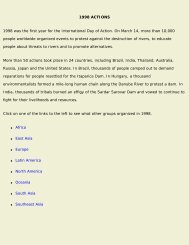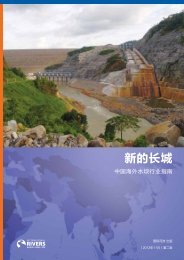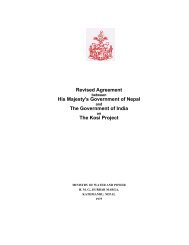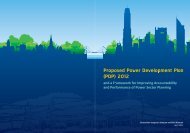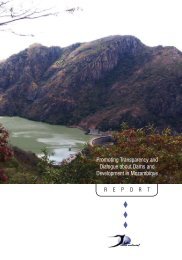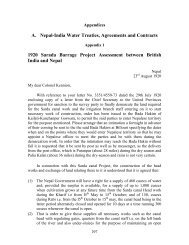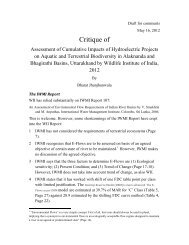At the fundamental level, however,as the hydropower sector turnsincreasingly to funds from outsidegovernment budgets, the availability<strong>of</strong> funding becomes more and moredependent upon the ability <strong>of</strong> the sectorto pay these back, and hence on itsability to recover its investments. Thisis true for funds raised for equity ordebt, from local or foreign markets,from banks or through bonds, indeed,for any funds that don’t come fromgovernmental sources, and for manythat do. The need for recovery <strong>of</strong> investment is especiallycritical for private developers. 69 Thus, being able to raisefunds will critically depend on whether the projects willbe able to sell power at the appropriate tariffs in the market.The key will be to achieve both high enough tariffs and thecreation <strong>of</strong> a market with enough paying capacity to buypower at the desired rates. This is precisely the aim <strong>of</strong> thepower sector “reforms” in India.The reforms consist essentially <strong>of</strong> transforming thepower sector to operate on a commercial basis. Key elements<strong>of</strong> the reform program include full cost recovery measures, anincrease in tariffs, the elimination or phasing down <strong>of</strong> directand cross subsidies, and the development <strong>of</strong> an electricitymarket with open access and merchant sale.Even with over 12 years <strong>of</strong> these reforms so far, theuncertainty <strong>of</strong> recovery <strong>of</strong> payments for electricity soldremains. As the Working Group on Power for the 11 th Planpoints out:The <strong>of</strong>f takers <strong>of</strong> power are mostly SEBs [StateElectricity Boards] and almost all <strong>of</strong> them (andtheir successor DISCOMS 70 ) continue to makecash losses. The lenders are extremely concernedover this and continue to seek a credible paymentsecurity mechanism that <strong>of</strong>ten entails suitable creditenhancement as may be required.However, till the time these entities start making cashpr<strong>of</strong>it, the concerned Governments may need toprovide suitable comfort to the lenders by signing/operationalising satisfactory escrow agreements orrequired changes in other project documents (PPA,etc). It must be re-emphasized that the utilities in thepower sector need to generate pr<strong>of</strong>its through levy <strong>of</strong>adequate user charges/recovery… 71Mechanisms like escrow 72 and guarantees have seriousimplications in that precious government and publicresources can end up being effectively mortgaged for privatepr<strong>of</strong>its. Also, the escrowable capacities and guarantees thatthe government can extend are limited. Thus, it is notassured that the projects, especially hydropower projects, willnecessarily be able to raise the required money from theWhile these high energy prices may ease theavailability <strong>of</strong> funds for power projects, they willpush electricity out <strong>of</strong> the reach <strong>of</strong> the poor.The fast expanding markets <strong>of</strong> those who canpay high energy prices beg the question – whatabout those who cannot?markets, as the reforms have made limited progress.On the other hand, whatever progress has been achievedby the reforms raises questions about the impact <strong>of</strong> thesemeasures on the poor. India’s Hydropower Policy 2008 states:“Lately, financial institutions have become more flexible…infinancing power projects, particularly hydro projects. Highenergy prices in a fast expanding power market have dilutedtheir insistence on water-tight PPAs backed by Governmentguarantees….there would be no dearth <strong>of</strong> funds for projectswith viable tariffs…” 73While these high energy prices may ease the availability<strong>of</strong> funds for power projects, they will push electricity out <strong>of</strong>the reach <strong>of</strong> the poor. The fast expanding markets <strong>of</strong> thosewho can pay high energy prices beg the question – whatabout those who cannot?The important question then becomes the impact <strong>of</strong>these measures (reforms) on the tariffs <strong>of</strong> the electricitygenerated, and the implications for access to electricity forthe poor. The reforms, and many <strong>of</strong> the incentives being<strong>of</strong>fered to the hydropower sector, are likely to lead to highertariffs. In the case <strong>of</strong> the Himalayan projects, distance fromload centres, difficult terrain and other factors will add tothe high capital costs <strong>of</strong> hydropower projects. There is areal danger that these projects will then end up generatinghigh-cost power supplied only to consumers with a highpaying capacity. This is an important concern. The NationalTariff Policy 2006 says: “Consumers, particularly those whoare ready to pay a tariff which reflects efficient costs, havethe right to get uninterrupted 24 hours supply <strong>of</strong> qualitypower.” 74 Is this a recognition and a pre-emptive defense <strong>of</strong>the fact that these policies are likely to lead to higher tariffs,which only a certain segment <strong>of</strong> consumers will likely beable to afford?It is important to note that as the major hydropowerprojects in Nepal and Bhutan are linked into the Indianpower system, these issues apply equally to them. The abilityto raise finances for projects being built by private developersin Nepal and Bhutan will be dependent on finding marketsin India at sufficiently high tariffs and with high levels <strong>of</strong>reliability <strong>of</strong> payments. In turn, the same issues <strong>of</strong> access forthe poor will become important.16 | <strong>International</strong> <strong>Rivers</strong>
Key PlayersKey players in the massive dam building programs in all four countries include the central and provincial governmentsand the respective energy or power ministries, public corporations set up to build hydropower projects, financialinstitutions – national and international, and contractors and equipment supply companies.Recent privatization trends and reform processes havebrought in a number <strong>of</strong> new players and institutions. Theseinclude the various electricity regulatory commissions,power trading companies and power exchanges, and <strong>of</strong>course the large number <strong>of</strong> private companies emerging asdevelopers <strong>of</strong> hydropower projects.Some <strong>of</strong> the key financial agencies have already beendiscussed above. Among the public sector developers <strong>of</strong> theprojects are the WAPDA in Pakistan, the Nepal ElectricityAuthority in Nepal and several publicly owned corporationsin India like NHPC Limited, North Eastern Electric PowerCorporation Limited (NEEPCO), and NTPC. Privatedevelopers are also emerging as important players in all fourcountries. Box 2 (page 18) lists some <strong>of</strong> the public and privatecorporations in India and the projects they are developing.Box 4 (page 20) explains the interests <strong>of</strong> Chinese companiesin dam building in the Himalayas.Many big and small players want to enter the hydropowerbusiness, as can be seen from the large number <strong>of</strong> privateplayers who have shown interest in hydropower projectsin Nepal. There are about 160 companies, individuals andcombinations there<strong>of</strong> who have submitted License forSurvey applications – which are currently under review– to the Department <strong>of</strong> Electricity Development (DoED)at the Ministry <strong>of</strong> Water Resources in Nepal. Included aremajor Indian companies like Lanco, GMR, Larsen andToubro, Jindal and Satluj Jal Vidyut Nigam Limited (SJVNL).Also on the list are several well-known former bureaucrats,politicians, businessmen and their relatives.Among the new institutions emerging from the powersector reforms that will play a major role in hydropowerdevelopment are the electricity traders.Trading <strong>of</strong> electricity has gained immense importanceIn the case <strong>of</strong> a hydropower plant, in the lateryears when the cost <strong>of</strong> production decreases afterdebt repayment is complete, developers have thechance to make huge pr<strong>of</strong>its by selling the power atprevailing high prices in the open market.Water and Power Development Authority (WAPDA), Pakistan,2007. WAPDA is a key public sector developer <strong>of</strong> hydropowerprojects in Pakistan. Photo: Ann-Kathrin Schneiderafter the introduction <strong>of</strong> the power sector reforms. This isespecially true for private project developers, as it is powertrading that holds the key to viability; or rather, the key tothe confidence that developers and financiers seem to havein getting assured returns from these projects. In particular,it is the provision <strong>of</strong> open access and merchant sales (sale<strong>of</strong> electricity directly to consumers, mostly bulk consumerswithout a long term PPA) <strong>of</strong> a large part <strong>of</strong> the generatedelectricity that seems to be an important attraction forthese developers. In the case <strong>of</strong> a hydropower plant, in thelater years when the cost <strong>of</strong> production decreases after debtrepayment is complete, developers have the chance to makehuge pr<strong>of</strong>its by selling the power at prevailing high prices inthe open market. [see Box 3, page 19] India’s hydropowerpolicy notes this when it says that “…from the point <strong>of</strong>view <strong>of</strong> the private sector themajor incentive is the scope fortrading – particularly in the lateryears when cost <strong>of</strong> generationgoes down and the market price<strong>of</strong> power is high.” 75While some <strong>of</strong> the openaccess and merchant sales arelikely to take place through directdeals between the generator andeither the distributor or theM o u n ta i n s o f C o n c r e t e : D a m B u i l d i n g i n t h e H i m a l aya s | 17




